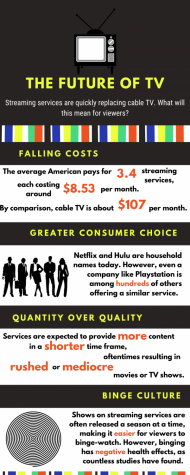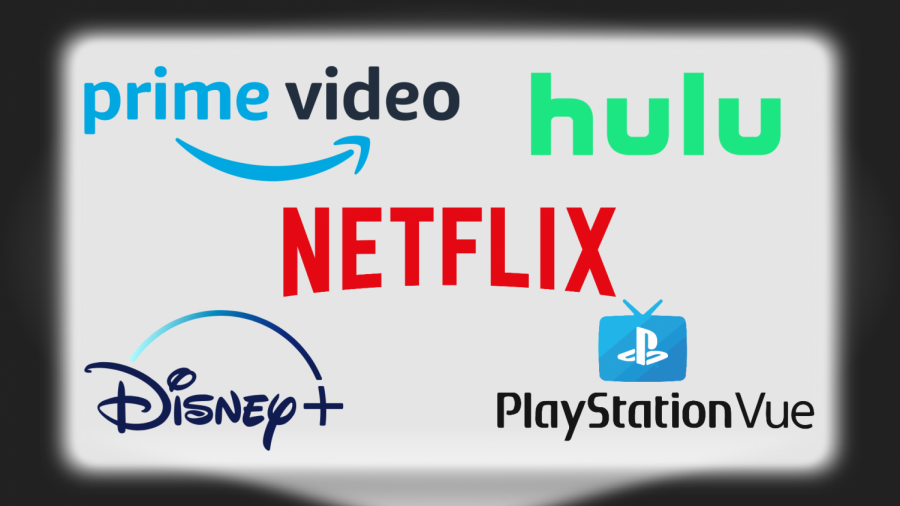Prime Time to Stream
One perspective on the impact streaming services have had on the quality of television
January 14, 2020
Streaming services have taken over traditional media. Many viewers have even abandoned cable TV for services like Netflix, Hulu, and Amazon Prime Video. According to Forbes, the average American pays for 3.4 streaming services, each of which averages $8.53 per month. Compared to the $107-per-month average cost of regular cable TV, it’s easy to see the reason most people are switching to new streaming services.
In 2007, Netflix was the first to stream movie content, changing from their mail-delivered movie rentals to instant access online. Hulu was soon to follow, opening their service up to the public the next year in 2008. These services quickly became very popular and have 88 million subscribers combined in the US alone. Netflix remains the more popular of the two, with 30 million more subscribers than Hulu.
After witnessing the success of these new streaming services, other companies decided that they wanted their share of this new market. Even companies like PlayStation, Facebook, and YouTube have added to the 100+ streaming services offered today. 
Throughout this year, the original streaming giants, Netflix and Hulu, are set to lose access to all movies and shows owned by Disney, WarnerMedia, and NBC, because of new streaming services being released by those companies. NBC owned binging favorites – Friends, The Office, and Parks and Rec – are just some of the most popular shows that will be removed from competing services. The Wall Street Journal reported that NBC shows “make up nearly 40% of the viewing minutes on Netflix.” Viewers will have to decide whether they are going to switch services or start paying for multiple subscriptions.
Additionally, almost every streaming service has begun to release original content that can only be watched on their site. Many of these shows starring well-known celebrities draw in more subscribers. On Amazon Prime, Carnival Row with Orlando Bloom and Cara Delevingne, and Living With Yourself starring Paul Rudd seem to be produced as fairly obvious marketing schemes to make money for the companies.
The biggest effect of the widespread use of streaming services is binge culture. There are countless articles about the negative physical effects of binging TV and movies, but the main focus here is how binging shows changes the way media is created and received.
While TV has a scheduled lineup for the shows to be aired, streamed media is available at the convenience of the viewer. People are more likely to watch shows they like when they have time to spend, which may lead to longer watch times during a single sitting. In turn, this has lead to shows being released an entire season at a time, instead of the usual single episode per week. This has a lot of benefits for the viewers who wish to binge-watch, but it may be hurting the quality of the content that is being released.
For popular shows such as Stranger Things, the majority of viewers watch the entire season the same week, or even the same day, that it’s released. If someone wants to avoid spoilers to experience the show for themselves or participate in the discussion of the show, they have to watch it during the first week of release. This leads to supersaturated content about the show for a few weeks and then almost zero mention of it until the next year when the next season is released.
Because the accessibility of streaming services has made people accustomed to watching content immediately whenever they want, companies are incentivized to produce more content over a shorter production time. Obviously, this can lead to rushed and often bad movies and shows. Yet, people will still watch because they just want to see new content. The competition between these different companies is becoming less about who creates the best content and more about who has the most shows to watch on their platform.
This isn’t to say that these companies aren’t producing good content; there are some truly good and innovative shows out there. As consumers, we have to be careful with what we spend our time on because that dictates the kind of content that we will receive. Who really wants Netflix to create another version of Tall Girl just because people watched it and talked about it?
Companies will pay attention to consumers especially if there are monetary implications. Remember that, for the future of streaming services, it’s up to the viewers to show these companies what they really want.












